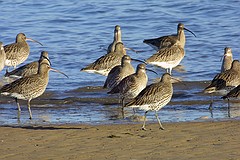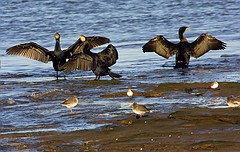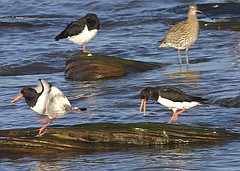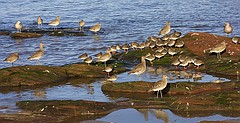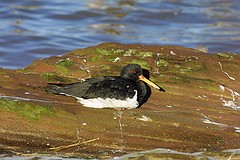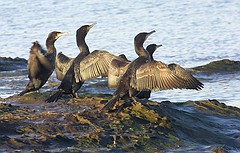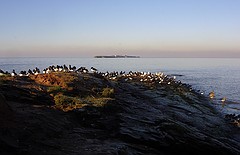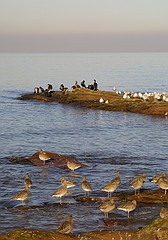Little Eye
It was a frosty day with a clear blue sky, and as I set off across the sand towards the smallest of the Hilbre Islands, the ridges left by the previous tide were hard, frozen solid. Perhaps this was because the sand was infiltrated by fresh water, because further out, the sand was soft.
When I got to Little Eye, I put my pack down and set up the hide, hammering the pegs through the top layer of frozen sand. As I was moving my kit into the hide, a cacophany of barks and high, shrill voices announced the arrival of a family group with accompanying pets, out for a Sunday walk. I drank my coffee as children and dogs scrambled excitedly over the rocks and pools, controlling my instinctive badger-watcher's irritation by reminding myself that the sea-birds would not care - if this had been a badger sett, I would be packing up to go home by now!
I had a bad feeling about all this disturbance, imagining how boring it was going to be, spending over five hours on Little Eye, surrounded by water, without a single bird in sight.
The tide came creeping up the gully between the islands and the shore, and just in time, the family departed, leaving me in sole possession of the tiny soon-to-be island. You are supposed to have somebody leave when you enter the hide as birds cannot count and think that everyone has gone, so I quickly got settled in the hide in case any birds were watching from a distance.
Directly in front of me, the tide rapidly filled the gap between Little Eye and Middle Eye, and to my relief and delight, birds began to alight on the rocks at the edge of the sea.
First to arrive were a few oyster-catchers, quickly followed by a big flock of curlews. To my right, the tide was rising up a sandy beach towards the island, and more birds arrived there.
A group of cormorants flew in and immediately hung their wings up to dry, followed by more and more oyster-catchers. Time passed quickly as birds arrived and the tide rose. A pair of shelduck swam elegantly past, and then from my left, I heard the distinct calls of geese. They eventually came into view, four brent geese, idly grazing the green vegetation on the rocks.
The small waders turned out to be nearly all redshanks, with just a few dunlin amongst them. The curlews towered amongst them, looking rather like teachers escorting an extremely well-behaved school party on a day out.
Little Eye has a small grassy top, perched on a sandy base resting on rock. I had pitched the hide in a sandy depression below the edge of the flat surface, so that it would not be on the bird's skyline, but I did not know how they would react to it. Would they be so familiar with the island that they would spot the unfamiliar shape and clear off in fright?
I got my answer as the sea closed tightly around the island, and the birds were pressed closer and closer to my hide. They did not care!
The cormorants moved closer as their roost became covered by the sea, but stayed on the furthermost point of rock. However, oyster-catchers, redshanks and curlews were crowded around within a few yards of me. Occasionally, birds would come along the grassy top and look into the hide through my small side-window, sidling away uneasily when I pointed a camera at them.
Any small noises that I made were hidden by the racket kept up by the birds, particularly the curlews, who were surprisingly argumentative.
Suddenly, a silence descended upon the island, as if a visiting speaker had called the assembly to order. Nothing was happening, even those birds who were not sleeping stopped all argument and conversation. I looked at my watch - it was high tide.
As the water began to recede, and I looked again at the incredible colour of the sea and sky, I felt as though I was on a tropical island, a fantasy which would have been more believable if it were not for the biting cold and the aches in my limbs.
More rocks and pools became available as the water fell, and many of the birds became restive, occasional small groups flying to the newly exposed beach. The sandpipers seemed first to be ready to start hunting, but most of the oyster-catchers slumbered on.
Eventually, as I was considering whether I should emerge from hiding, most of the birds took to the air with a huge roar of wings. I was wondering what I had done to frighten them when I heard a strange noise. With stiff, uncoordinated limbs, I emerged and climbed on top of the island in time to see a horse and rider beginning to return through the shallow water to the distant shore.
Exhilarated by the experience, I packed up my kit and drank a cup of coffee while my circulation returned and my legs learnt how to support me with some reliability again. I then set off across wet flats towards West Kirby.
As I crossed one of the gutters still containing a couple of inches of seawater slowly withdrawing, I took slow, careful steps to avoid getting my feet wet. Each movement of my boot created a little wave which bent the golden light from the low winter's sun behind me towards the sand. As I glanced to each side, I found that parallel waves, glowing with the golden light, were accompanying me across the gutter.
Places can be magical, but only if people see the magic. I'll be going back to Little Eye.
Want to see more pictures taken on the day? Click here for the Little Eye Gallery.
All text and graphics © Pat Bennett 1996-2003



